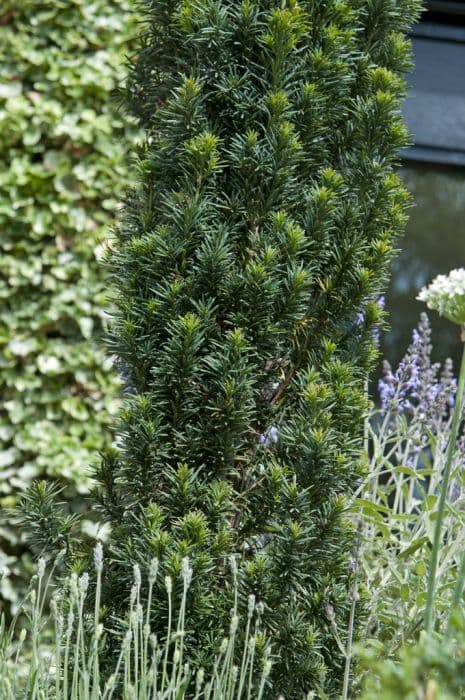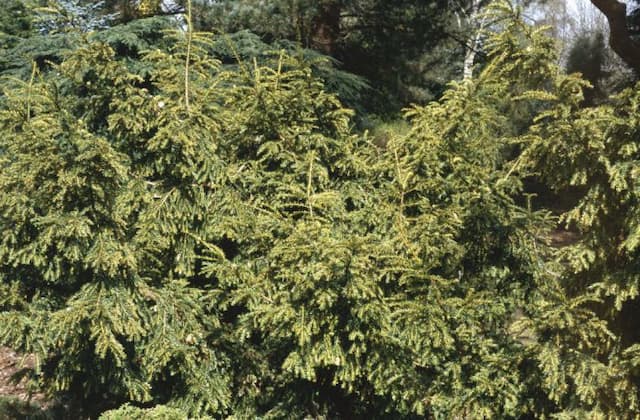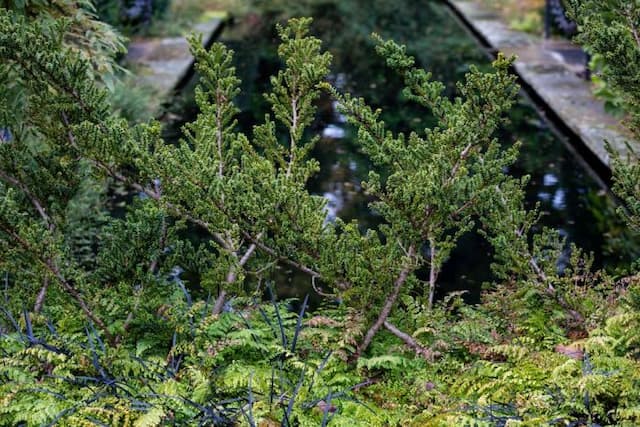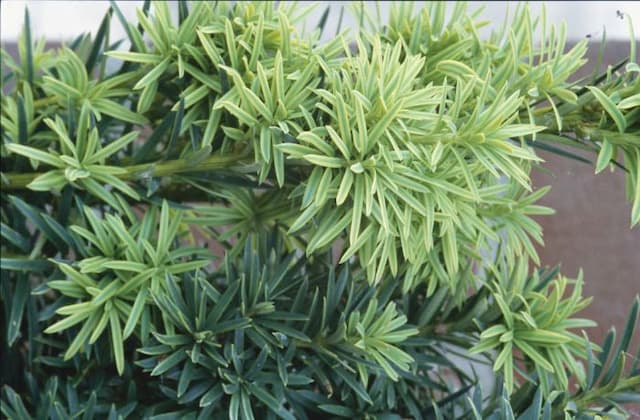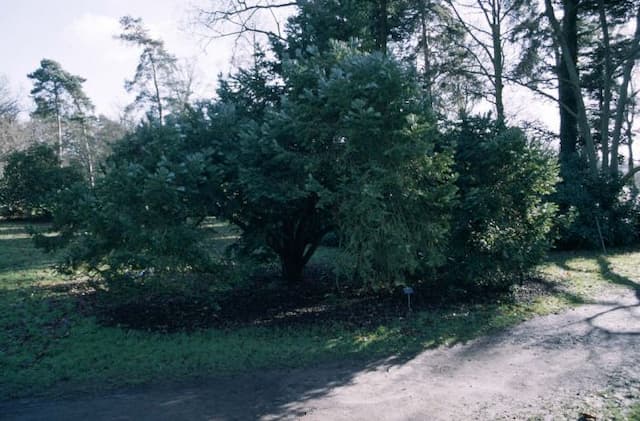Taxus baccata 'Repens Aurea' (v)

ABOUT
The plant known as the Golden Spreading Yew is a distinctive variety characterized by its striking foliage. This plant boasts a spreading habit with gracefully arching branches. The leaves are a delightful mix of colors, where the new growth emerges a golden yellow, adding a bright contrast to the mature, dark green needles. This unique coloration makes the Golden Spreading Yew particularly eye-catching throughout the year, as the gold-tipped leaves stand out against the darker, older foliage and provide a stunning visual interest in garden settings. The Golden Spreading Yew also produces small, red, berry-like fruits that add an additional splash of color against the green and gold of the needles. These fruits are typically seen in autumn and can persist into the winter, providing a seasonal display and food for local wildlife. Overall, its evergreen nature and variegated leaves ensure that the Golden Spreading Yew remains a focal point in any landscape throughout the seasons.
About this plant
 Names
NamesFamily
Taxaceae
Synonyms
Golden Spreading English Yew, Golden Spreading Yew, Aurea Repens Yew
Common names
Taxus baccata 'Repens Aurea' (v).
 Toxicity
ToxicityTo humans
The English yew is highly toxic to humans if ingested. All parts of the plant, except the flesh of the berries, contain alkaloids such as taxine, which can cause acute cardiac toxicity and central nervous system effects. Symptoms of English yew poisoning may include dizziness, dry mouth, dilation of the pupils, abdominal pain, and an irregular heartbeat, which can lead to death if a significant amount has been consumed.
To pets
The English yew is also highly toxic to pets, including dogs, cats, and horses. Toxic compounds such as taxine are present in the leaves, seed, and bark. Symptoms of poisoning in pets can include vomiting, difficulty breathing, tremors, seizures, and potentially fatal changes in heart rate and blood pressure. Ingestion of even a small amount of the English yew may result in life-threatening situations or death in pets.
 Characteristics
CharacteristicsLife cycle
Perennials
Foliage type
Evergreen
Color of leaves
Varies
Height
1-3 feet (0.3-0.9 meters)
Spread
4-6 feet (1.2-1.8 meters)
Plant type
Shrub
Hardiness zones
7
Native area
Europe
Benefits
 General Benefits
General Benefits- Ornamental Value: Taxus baccata 'Repens Aurea', commonly known as Golden Spreading Yew, adds visual interest to the landscape with its unique golden foliage and spreading habit.
- Drought Tolerance: Once established, it has a good tolerance for drought conditions, making it suitable for regions with occasional water scarcity.
- Shade Tolerance: The plant thrives in partial shade, allowing for versatile planting locations within a garden or landscaped area.
- Low Maintenance: Golden Spreading Yew requires minimal pruning and care once it is established, making it an ideal choice for those seeking low-maintenance gardening.
- Soil adaptability: It can adapt to a wide range of soil types as long as the soil is well-drained, offering flexibility in planting sites.
- Wildlife Habitat: Although not directly used for food, it provides cover for birds and other small wildlife.
- Year-Round Interest: With its evergreen foliage, it offers visual interest throughout the seasons, even in the cold months of winter.
- Erosion Control: The dense growth habit can help stabilize soils on slopes and prevent erosion.
- Privacy Screen: Its dense foliage and spreading nature can be used to create a natural privacy screen or hedge in gardens or property borders.
- Formal Appearance: It can be shaped and trimmed for a more formal appearance, which is suitable for structured garden designs.
 Medical Properties
Medical PropertiesThis plant is not used for medical purposes.
 Air-purifying Qualities
Air-purifying QualitiesThis plant is not specifically known for air purifying qualities.
 Other Uses
Other Uses- Taxus baccata, or the English Yew, is sometimes used in the creation of bonsai trees due to its ability to adapt to pruning and shaping.
- The dense foliage of the English Yew can be used as a sound barrier when planted in rows along busy streets or between neighboring properties to reduce noise pollution.
- English Yew wood is prized for its fine grain and resistance to splitting, making it an excellent material for crafting detailed wooden sculptures and intricate ornamental objects.
- The slow growth rate of Taxus baccata makes it a prime candidate for topiary gardens, where it can be sculpted into various formal shapes and maintained with precision.
- Due to its evergreen nature and tolerance for shade, English Yew is often planted in cemeteries to provide year-round greenery and a solemn atmosphere.
- Its dense branches and foliage provide habitat and nesting sites for various bird species, offering an ecological benefit by supporting local wildlife.
- The wood of English Yew, being strong and resilient, has been historically used to craft longbows, particularly during the Middle Ages in Europe.
- The winter berries of the English Yew, although toxic to humans, can be used to attract and feed birds during the colder months when other food sources are scarce.
- English Yew hedges serve as effective windbreaks in rural and exposed sites, protecting gardens and fields from wind damage.
- The plant's ability to grow in a variety of soils, including poor or compacted soils, makes it a practical choice for urban planting to greenify harsh city landscapes.
Interesting Facts
 Feng Shui
Feng ShuiThe English Yew is not used in Feng Shui practice.
 Zodiac Sign Compitability
Zodiac Sign CompitabilityThe English Yew is not used in astrology practice.
 Plant Symbolism
Plant Symbolism- Longevity: The common yew (Taxus baccata) is known for its long lifespan, symbolizing endurance and the continuity of life through the ages.
- Resurrection: The yew tree's ability to regenerate, with new shoots growing from old trunks, is often seen as a representation of rebirth and resurrection.
- Immortality: Due to the yew's long life and evergreen nature, it has been associated with immortality and the eternal aspect of the human soul.
- Protection: Historically, yew trees were planted in graveyards and churchyards, believed to offer protection to the dead and keep evil spirits at bay.
- Transition: The yew can symbolize the transition between life and death, as it has been traditionally linked with both funerary practices and everlasting life.
 Water
WaterThe Golden Spreadwing Yew should be watered when the top layer of soil feels dry to the touch, which typically means watering once every week or two, depending on climate conditions. Provide a consistent amount of water to keep the soil evenly moist but not waterlogged; usually deploying around 1.5 gallons over a two-week period will suffice. During the summer or in dryer periods, increase the frequency of watering. However, in the dormant winter season, reduce watering as the plant requires less moisture. Ensure proper drainage in the pot or the ground to prevent root rot, which can be devastating to this plant.
 Light
LightGolden Spreadwing Yew thrives best in partial shade to full sun. It should be placed in a spot where it can receive at least four hours of direct sunlight daily but is also protected from the intense midday sun. Morning light is ideal as it's less harsh than afternoon sunlight. The plant can also adapt to full sun if slowly acclimatized, but its best foliage color often comes from a location with dappled or mixed sun and shade.
 Temperature
TemperatureThe Golden Spreadwing Yew is a hardy plant that can tolerate a range of temperatures, thriving ideally in conditions between 50 and 70 degrees Fahrenheit. It can withstand cold down to about -30 degrees Fahrenheit and is thus suitable for many temperate climates. Protect the plant from extreme heat, which can cause stress, by ensuring it has adequate moisture during hot spells.
 Pruning
PruningPruning the Golden Spreadwing Yew is beneficial for maintaining its shape and encouraging dense growth. It should be pruned in late winter or early spring before new growth starts. Light trimming can be done again in mid-summer if necessary. Remove any dead or damaged branches whenever they are noticed to keep the plant healthy. Prune selectively rather than shearing to maintain the plant's natural form.
 Cleaning
CleaningAs needed
 Soil
SoilThe Golden Spreading Yew requires well-draining soil with a pH range of 6.0 to 7.0. An ideal soil mix for this plant would include equal parts of loamy soil, peat, and sharp sand to ensure adequate drainage and aeration. Top dressing with organic matter annually will help maintain soil fertility.
 Repotting
RepottingGolden Spreading Yew, being a slow-growing conifer, does not require frequent repotting. Repotting every 3-5 years is sufficient unless the plant shows signs of being root-bound sooner.
 Humidity & Misting
Humidity & MistingGolden Spreading Yew thrives in moderate humidity levels. Average room humidity or slightly higher is ideal for this plant, avoiding excessively dry air which could cause needle desiccation.
 Suitable locations
Suitable locationsIndoor
Place in bright, indirect light with moderate humidity.
Outdoor
Plant in well-draining soil; partial to full sun exposure.
Hardiness zone
6-7 USDA
 Life cycle
Life cycleTaxus baccata 'Repens Aurea', commonly known as the Golden Spreading Yew, begins its life cycle when seeds are dispersed, often by birds that eat the fleshy aril surrounding the toxic seed. Germination takes place under appropriate moisture and temperature, though it is relatively slow and may require a cold stratification period. The plant then enters the seedling stage, gradually establishing a root system and producing its characteristic needle-like leaves that vary from yellow to green as it ages. As it matures, it enters a prolonged vegetative stage where it spreads horizontally much more than vertically, forming a low, dense mat of foliage which can be very long-lived, with some specimens reaching several centuries in age. It eventually reaches reproductive maturity, producing small, inconspicuous flowers that are dioecious, meaning individual plants are either male or female. Female plants, if pollinated, will develop red, berry-like structures called arils that encase the seeds, completing the cycle.
 Propogation
PropogationPropogation time
Early Spring
The most popular method of propagating the English Yew 'Repens Aurea' is through semi-hardwood cuttings. This process typically takes place in late summer to early fall. Semi-hardwood cuttings are portions of the plant's stem that have matured slightly but still retain some flexibility. For this plant, the cuttings should be about 6 to 8 inches long (approximately 15 to 20 centimeters). The bottom inch of the cutting is dipped in rooting hormone before being placed in a well-draining potting mix. The cutting should then be kept consistently moist and placed in a location with indirect sunlight. Rooting can take several weeks to months, and once roots have formed, the new plants can be transferred to a more permanent location.
